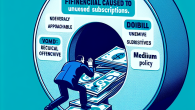
Do You Really Need That Coffee Subscription? Financial Minimalism 101
How to Create Your First Budget (Without Losing Your Sanity)
Hey there, newbie in the world of dollars and cents—welcome! I’m Tom Bradley, your go-to guy for making the world of personal finance a little less scary and a lot more doable. If the word “budget” makes you want to sprint in the opposite direction, I totally get it. But breathe easy, friend—creating your first budget doesn’t require a finance degree or giving up your daily latte. All it takes is a little planning, a sprinkle of discipline, and heck, maybe a spreadsheet or two.
In this guide, I’ll walk you through how to build your first budget step by step, minus the fluff and financial jargon. Let’s do this the Tom Bradley way—clear, honest, and a little fun. Ready?
What Is a Budget, Really?
A budget is simply a plan for your money. That’s it. It’s not a prison sentence or a strict diet for your wallet. It’s just telling your money where to go instead of wondering where it went at the end of every month.
You earn money, right? You spend money, right? A budget helps you make sure those two activities are getting along nicely without dragging you into debt or stress.
Why Should You Create a Budget?
Here’s where the magic happens. A solid budget can:
- Help you avoid debt (because who needs more stress?)
- Make saving easier—yes, even on a small income!
- Keep your financial goals on track, whether it’s buying a car or taking that vacation in Greece
- Give you peace of mind knowing you’re in control of your money
And frankly, once you get into the habit, it’s kind of addictive. There’s something empowering about knowing exactly where your money is going and *why*. Let’s dive into the “how.”
Step 1: Know Your Monthly Income
First things first—how much money are you bringing in each month? This isn’t just your salary. Include:
- Salary (after taxes)
- Side gigs (Uber, Fiverr, selling handmade candles—you name it)
- Income from rental properties or freelance work
- Any government benefits or scholarships
Total that up. That’s your monthly income, or the amount you’re working with when it comes to budgeting.
Step 2: Track Every Single Expense
Yeah, all of them. Even that impulse boba tea purchase at 3 p.m. on a Tuesday. For one month (preferably this month), track everything you spend. Apps like Mint, YNAB, or even Excel can help with this.
Break Your Expenses into Categories
Once you’ve gathered a full month of transactions, divide expenses into two main groups:
- Fixed Expenses: Same amount every month. Think rent, car payments, streaming subscriptions.
- Variable Expenses: These change each month. Think groceries, eating out, fun money, gas.
Pro tip: Don’t lie to yourself here. If you’re spending $250 on Friday DoorDash orders, write it down. It’s all part of the process.
Step 3: Set Your Budgeting Goals
Now that you know what’s coming in and going out, ask yourself: what do you actually want your money to do for you?
Here are some popular financial goals:
- Save for an emergency fund (aim for 3–6 months of expenses)
- Start investing for the future
- Pay off debt (student loans, credit cards)
- Buy a laptop, car, or house (it’s doable!)
Pick one or two to start with. This will give your budget purpose—not just a bunch of numbers on a page, but a tool for something you actually want.
Step 4: Use a Budgeting Method That Works for YOU
There are tons of budgeting systems out there, but here are the top three that are beginner-friendly and Tom-approved:
1. The 50/30/20 Rule
This one’s simple and works wonders:
- 50% of your income goes to needs (rent, groceries, car, bills)
- 30% goes to wants (eating out, Netflix, weekends out)
- 20% goes to savings or debt repayment
Perfect for beginners who want structure without feeling trapped.
2. Zero-Based Budgeting
Every dollar has a job. If you make $2,500 a month, you “assign” each dollar to a category until there’s zero left “unemployed.” It’s like running a business—your money has roles.
3. Envelope System (Cash-Only)
This old-school method involves taking cash and dividing it into actual envelopes by category (like “groceries” or “entertainment”). When the envelope’s empty, you’re done spending for that category. Great for hands-on learners!
Step 5: Plug In the Numbers
Time to make your budget spreadsheet (or use an app), and start filling in your income and allocating it to your categories.
Example:
- Income: $2,500/month
- Rent: $900
- Groceries: $350
- Car payment: $300
- Phone: $80
- Eating out: $150
- Savings: $300
- Gym: $50
- Entertainment: $100
- Emergency fund: $270
Boom—you’ve got a totally functional first budget.
Step 6: Stick to It (But Give Yourself Grace)
Here’s the thing about budgets: your first one won’t be perfect. Neither will your second. That’s NORMAL.
The goal isn’t perfection. It’s progress. If you overspend one month, adjust the next. Financial health is like physical health—consistency is more important than being strict or flawless.
Check in weekly to make sure you’re on track. Monthly, evaluate and tweak as needed.
Final Tips From Your Friendly Financial Guide
- Use free resources to educate yourself — podcasts, YouTube channels, blogs (like this one!).
- Automate savings so you don’t even think about it—just set it and forget it.
- Celebrate small wins. Stuck to your budget for a week? Treat yourself (within budget, of course).
Remember, your budget is YOURS. Make it work for your life, not against it. And if you ever get stuck, overwhelmed, or just need a financial pep talk, I’m here—virtual high-five and all.
Welcome to the world of smart money management. You’ve got this!
Looking to learn more about our team? Check out our about us page. Got questions? Contact us here.









Leave a Reply